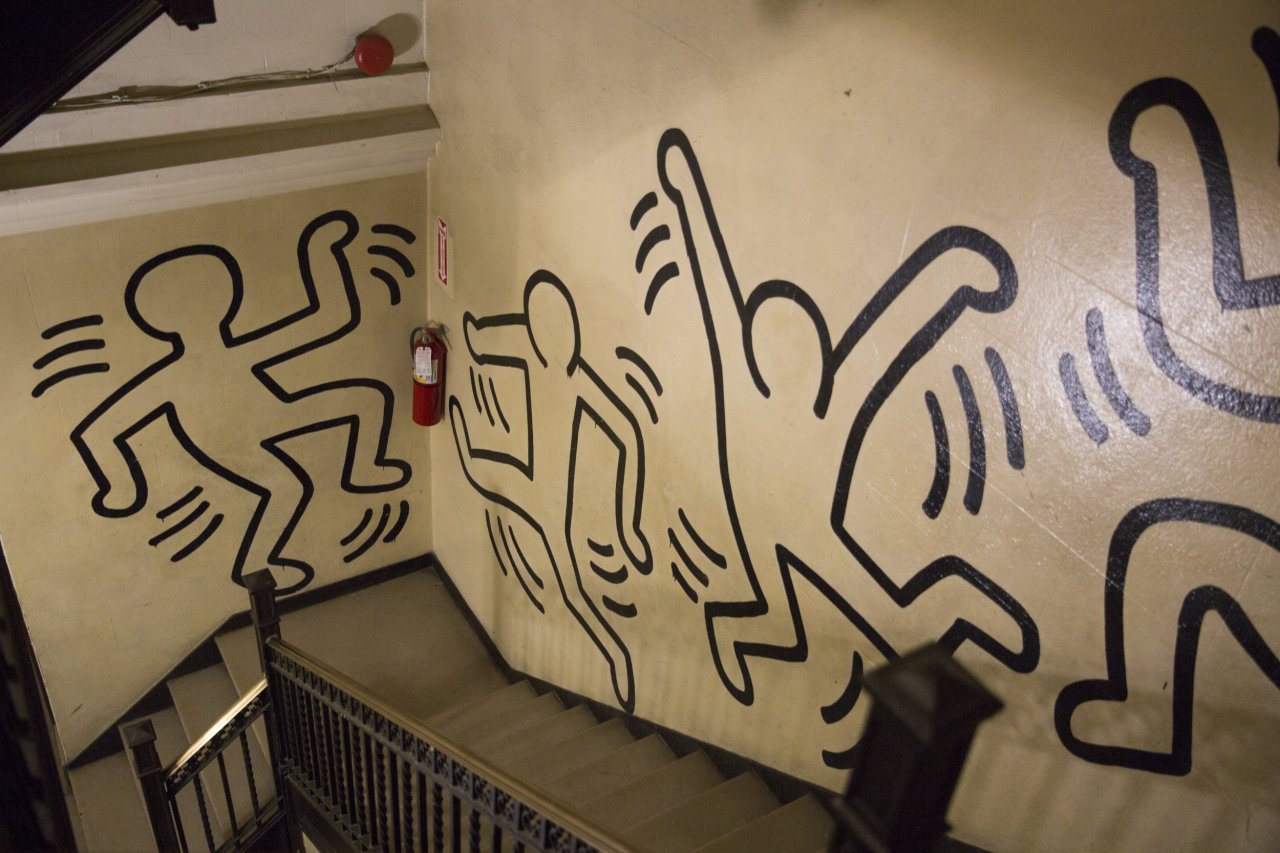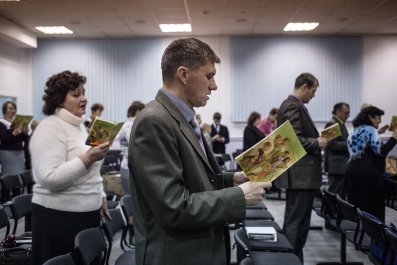Keith Haring practiced making art quickly. In the early '80s, he would ride the New York City subway, scouting the stations for spots where sheets of plain black paper hung until advertisements replaced them. He'd saunter up, look around for police and fill the paper with cartoonlike figures. Sometimes, it got him arrested.
One Saturday evening, most likely in 1984, Haring walked into a building on 108th Street, passing under a small cross above the front door. The thin, bespectacled artist carried a coffee can filled with black paint and a thick brush, ready to cover the walls of the former convent. A friend invited Haring to tag the wall and got the approval of Gary Mallon, director of the youth center in the building. The leaders of the church that owned the building didn't know Haring was there.
Haring started at the bottom of the stairs and wound his way up to the third floor, crouching low and then almost reaching the ceiling in some spots. He painted outlines of figures walking, running, jumping, embracing—limbs askew and vibrating with curved echo lines that gave the walls a feeling of constant motion. That night, dozens of teenagers were inside the Grace House youth center, which was run by the Catholic Youth Organization, and they trickled into the halls to watch him paint.
"I think it took about 40 minutes. It was so fast...and there was no sketch. It just flowed out of him," says Mallon. "He would paint [the figures] as he was moving. It was coming out of his head through the brush and onto the wall."
The spontaneous mural ends at the third-floor landing with a figure seeming to dive into a doorway, only its lower half visible. When the building was a convent, the door led to the mother superior's apartment, but in those years it was home to Mallon. "That's you, Gary," he remembers Haring saying, explaining that it was Mallon escaping into his apartment after a long day working with the kids. Back downstairs in the lobby, Haring added his archetypal "radiant baby" to an empty wall—an outline of a crawling child surrounded by sunny beams.
Just six years later, the world-famous artist died from AIDS-related complications at the age of 31. By then, he'd shown his work in more than 100 solo and group exhibitions across the globe; collaborated with artists like Grace Jones, Yoko Ono and Bill T. Jones; and painted murals in prominent spots, including hospitals, museums and the Berlin Wall.
Now, more than three decades after Haring painted his mural for the kids of Grace House, the church is emptying the building of tenants and "exploring its options," which means a massive work by an art icon—extremely valuable and simultaneously priceless—could be destroyed.
Crack Is Wack
The story of how the mural came to be is also the story of a Puerto Rican teenager from the South Bronx. Benny Soto, a self-described poor kid who was a regular volunteer at Grace House, had no exposure to any kind of fine art growing up; it was an interest in clubbing as a teenager that brought him into the art world. He discovered the Paradise Garage in the early '80s and quickly became a fixture at the SoHo discotheque, where he kept seeing pins and T-shirts featuring a mysterious glowing baby. Someone finally pointed him to Haring's show at the Tony Shafrazi Gallery, where the artist had turned the basement of an annex around the corner into a "break-dance disco" with black lights, fluorescent paint, DJ equipment and a party every night. It was there and at the Garage that Soto befriended Haring, who eventually hired the teenager to be his studio assistant.
Soto can't pinpoint the exact moment he got the idea that Haring should paint at Grace House. Haring knew Soto and his friends spent a lot of time hanging out and volunteering there, and Soto remembers asking him several times if he would make something for the kids. Haring agreed and so did Mallon, who decided it best not to ask the church for permission. And so, late on a winter night, Haring arrived with his coffee can. "Keith was such a nice, generous guy," says Mallon, now a professor at Hunter College's Silberman School of Social Work. "He wanted nothing in return."
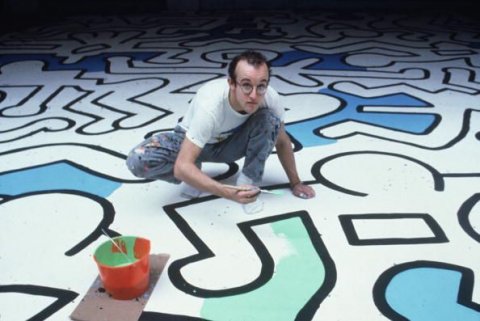
Soto remembers feeling the mural was a gift for all the kids, most of them poor, who found a safe space at the youth center. "There's certainly a lot of movement and joy in the figures as you go up and down the steps. In an ultra-simplistic way, he captured it: That's what Grace House felt like. There were always kids running up and down the steps."
Soto worked as Haring's studio assistant for about 18 months, running to the art supply store, buying lunch, delivering paintings, stretching canvases. But he also became friends with the artist, entering Haring's social circle, which included Andy Warhol as well as pop stars Boy George and Madonna, who performed "Like a Virgin" for Haring's birthday party in 1984, wearing an outfit designed by the artist, months before the single was released. Haring took Soto overseas for the first time when he had work in Amsterdam and Paris.
Working for Haring was an exhilarating experience, Soto says, until he "got wrapped up doing a lot of drugs and hanging out. I had to really take a step back and get myself together…. Keith was very, very supportive," even after Soto stopped working for him.
It was Soto, in part, who inspired one of Haring's most famous public works in New York City—the "Crack Is Wack" mural he painted in 1986 on the wall of an abandoned handball court uptown, on Harlem River Drive. "Now, there's a very personal reason why I wanted to do this particular mural," Haring is quoted as saying in a biography by John Gruen. "Back in 1984, I hired a young studio assistant. He was a Puerto Rican kid—very intelligent, top star of his school, and ready to go to medical school. He did volunteer work for a Catholic community center and he was just an all-around good and wonderful person. But, little by little, he became a crack addict…. I got really distressed…. But because he was also intelligent, he wanted desperately to stop. Finally, he was put on a program and, thank God, he was cured."
Within a year after Soto got sober in the late 1980s, Haring was diagnosed with AIDS. Soto will never forget one of his last visits before Haring's death in February 1990. The artist was changing his shirt in his studio before they headed out somewhere, and Soto saw lesions on his back. He knew what they were but didn't want to believe it, so he asked. "Bennnnny, come on," he recalls Haring saying, mimicking the impatience on his face and in his voice. "I have AIDS."
The last time Soto saw Haring, he was no longer the same energetic man buzzing around the studio or dancing up the stairs as a mural poured out of his brush. "It was devastating to see…. You feel so powerless," says Soto, who cried as he walked away from the studio that day. "It was so sad. He was so young and so talented. I think he would have done so much more."
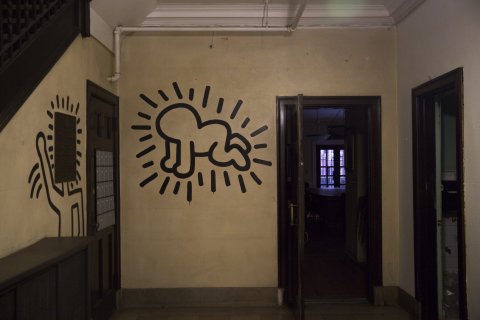
Moving in With the Mural
The Grace House mural went largely unharmed while the five-story building was used for various purposes over the past 30 years. It has been owned by the Church of the Ascension for nearly a century. From 1977 until 2008 or 2009, the Catholic Youth Organization rented Grace House for retreats and other programs for kids. The building then became host to a hodgepodge of organizations and activities, some of which continued after the church started renting out rooms as apartments around 2013. Since then, a motley, multigenerational group, including artists, students and teachers, has lived there, sharing bathrooms and kitchens.
Robert Savina, a production designer for low-budget independent films, found Grace House while scouting locations. "When I first saw the mural, it was this immediate connection," he tells Newsweek. He happened to be looking for a place to live, and when he heard there was a room available on the fourth floor, he says, "I knew this was home."
He's been living with the Haring for over two years now. It "always energizes me. It's a very uplifting piece of art. I notice something different about it each time I walk by," like the spots where Haring must have started a brushstroke with a fresh load of paint, leaving a few drops trailing below the confidently drawn lines.
Like the rest of his neighbors, Savina received a letter in April asking him to move and a more formal legal notice in June requesting he vacate the premises by July 31. The only explanation was a brief mention of the church's "financial health." As the tenants scrambled to arrange for new housing, they worried about the mural. They feared it would be destroyed if the church leased or sold the property.
The church has yet to reveal its plans. Joseph Zwilling, director of communications for the Archdiocese of New York, tells Newsweek, "There has been no decision yet about the future of the building in question and therefore no decision about the mural itself."
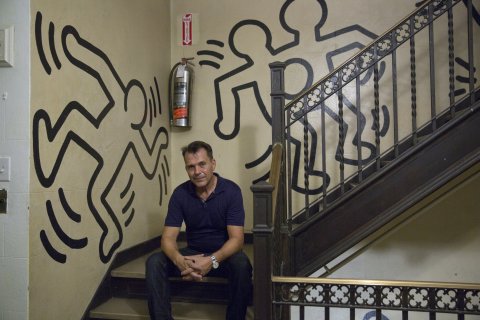
All but two of the tenants—Savina and a young woman on the fifth floor named Yana Sabeva—have moved out, even though lawyers believe they are protected by rent stabilization laws. Aaron Kratzat, an attorney at the Goddard Riverside Law Project, says the Grace House tenants should have the right to stay indefinitely, but a judge denied Savina and Sabeva an injunction that would prevent the church from starting eviction proceedings, and now they're waiting for the church's next move.
In the meantime, the mural captured the attention of the local news site DNAinfo, whose coverage sparked a wave of publicity, and New York City Councilman Mark Levine, who wants to ensure that it cannot be ruined and believes the "only rock-solid way to protect it is to landmark it." He has approached the city's Landmarks Preservation Commission about beginning that process.
Savina's staying, at least in part because of the mural. He figures that no one can knock down the building while he and Sabeva are living in it.
The Friends They Lost
This summer, more than 30 years after he'd last hung out at Grace House, Soto went to see what he calls "the forgotten mural." After Savina let him in, the pair showed each other around. When they reached the rooftop garden, they sat and talked for over an hour about New York City in the 1980s, about drugs and drinking, about AIDS and the friends they lost, and about the mural.
"Can we look at it one more time?" said Soto, now a promoter for electronic dance music events and a DJ, and they meandered back downstairs. Beneath the right sleeve of Soto's black T-shirt, there's a tattoo Haring inked when the famous tattoo artist Hanky Panky was teaching him to use a tattoo machine in Amsterdam. It's faded, but you can still make out Haring's well-known "Batman" figure, with a cape spread behind him and an X on the belly.
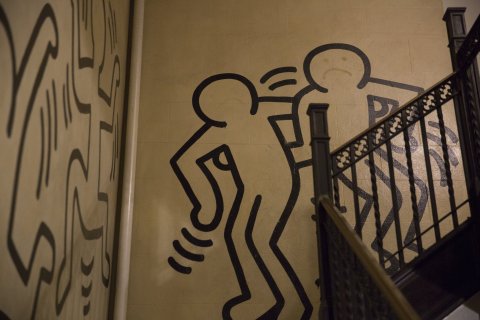
As they lingered over their goodbyes by the front door, Soto said he thought Savina might save the Haring work. "You're lucky to have the mural, but the mural is also lucky to have you."
After Haring's old friend walked away, Savina closed the door to Grace House and went to his room. Though it's on the fourth floor, you can bet he took the stairs for one more look.



